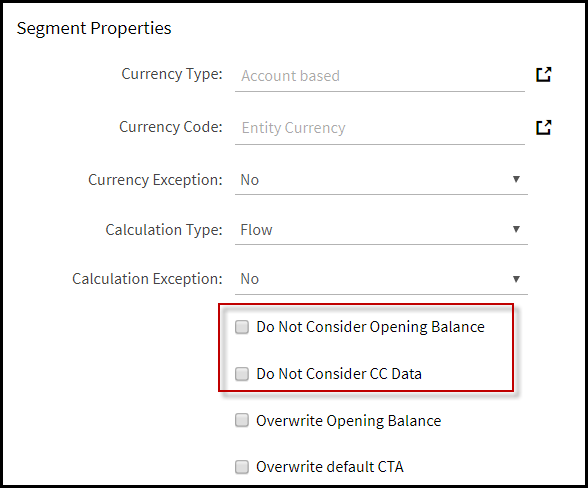- 21 Minutes to read
- Print
- DarkLight
- PDF
Security and Accounts
- 21 Minutes to read
- Print
- DarkLight
- PDF
Consolidation Security
Consolidation Security Overview
In the Consolidation Control Panel, access the Security task to setup security for Centralized and Decentralized users. A centralized user has access to all company members in a scenario. A decentralized user has access to specific dimension members only. The Company/Legal Entity Member Selector distinguishes between Centralized and Decentralized Consolidations. If you are at the root member (defined as the top member in the hierarchy), then you are interacting as a Centralized user managing the Consolidation Process in its entirety. If you have been provided specific member access within the hierarchy and you select a Company from the member selector, then you are interacting in Decentralized mode. This means that the modules available may be restricted and you may have limited access to Company intersections for modifying data.
To access Consolidation Security, navigate to Consolidation and click the Security link under the Administration pane. Or you can also find it under the User Actions section in Maintenance > Admin > User & Role Management.
Centralized Security
Quick Reference Process Table
This quick reference table provides information on each action/security as it applies to each process.
Process | |||||||||
|---|---|---|---|---|---|---|---|---|---|
Action | Standard Journal | Recurring Journal | Dynamic Journal | Non Controlling Interest | Reclass | Eliminations | Actual Data Load | Validations
| Consolidation Process |
Full | Enables all entry and approval actions. Active/Inactive is not applicable. | Enables user to manage all Recurring Journals and post/process. | Enables user to manage all Dynamic Journals and active/inactive applies. | Enables user to manage all non controlling interest and active / inactive applies. | Enables user to manage all reclasses and post/process. | Enables user to manage all Eliminations, clear /unpost, and post/process. | Provides user with ability to load data using Actual Data Load templates in Decentralized mode. User can perform template input and all privileges associated with Actual Data Load. | Enables user to manage all Validations, clear/unpost, post/process, and active /inactive applies.
| Allows user to run the Consolidation Process. |
Manage | Allows user to access Standard Journals, add new journals, and edit journals. . | Allows user to access Recurring Journals, add new journals, and edit journals. | Allows user to access Dynamic Journals, add new journals, and edit journals. | Allows user to access Non Controlling Interest, add new rules, and edit rules. . | Allows user to access Reclasses, add, and edit. | Allows user to access Elims, add, and edit. | Not Applicable. | Allows user to access Validations, add and edit. | Not Applicable. |
Forward | Submit an entry for review. Select a journal entry that is in process and click Forward to move the entry to Pending Review. | Not Applicable. | Not Applicable. | Not Applicable. | Not Applicable. | Not Applicable. | Not Applicable. | Not Applicable. | Not Applicable. |
Send Back | Return a journal entry to an In Process status to make required changes. This option is only available when the journal is in the Pending Review or Approved statuses. | Not Applicable. | Not Applicable. | Not Applicable. | Not Applicable. | Not Applicable. | Not Applicable. | Not Applicable. | Not Applicable. |
In Process | A journal entry that has not in a forwarded state. | Not Applicable. | Not Applicable. | Not Applicable. | Not Applicable. | Not Applicable. | Not Applicable. | Not Applicable. | Not Applicable. |
Approve | Approve a journal entry that is Pending Review, which confirms the entry for posting. | Not Applicable. | Not Applicable. | Not Applicable. | Not Applicable. | Not Applicable. | Not Applicable. | Not Applicable. | Not Applicable. |
Post / Process | Post the entry to the application. Once posted, a message indicates whether the post was successful or not. | Post the entry to the application. Once posted, a message indicates whether the post was successful or not. You can give a user the ability to post a journal without having full control. | Not Applicable. | Not Applicable. | Post the reclassification to the application. Once posted, a message indicates whether the post was successful or not. | Post the Elimination to the application. Once posted a message indicates whether the post was successful or not. | Not Applicable. | Post the Validation to the application. Once posted a message indicates whether the post was successful or not | Automatically enabled when Full is selected. Entries will post during Consolidation. |
Reject | Refuse a journal entry. To re-use a rejected journal, create a copy of it (which will return the entry to the In Process status) with a new name. | Not Applicable. | Not Applicable. | Not Applicable. | Not Applicable. | Not Applicable. | Not Applicable. | Not Applicable. | Not Applicable. |
Unpost / Clear Data | Current period or prior period journals can be unposted. This action removes the original posted entry from the system. | Not Applicable. | Not Applicable. | Not Applicable. | Not Applicable. | Current period or prior period Eliminations can be unposted. This action removes the original posting from the system. | Not Applicable. | Current period or prior period Validations can be unposted. This action removes the original posting from the system. | Not Applicable. |
Active / Inactive | Not Applicable. | Not Applicable. | The journal entries that are valid for the period in which they are defined when created. | The non controlling interest that are valid for the period in which they are defined when created. | Not Applicable. | Not Applicable. | Not Applicable. | The Validations that are valid for the period in which they are defined when created. | Not Applicable. |
It is important to note that entry and approval actions that users don't have access to will display in the actions pane, however, these users will not be able to perform the displayed actions. When an action a user doesn't have access to is selected by that user, a message will display indicating so.
Decentralized Security
Use the Decentralized tab to grant distributed users access to Consolidation activities. Upon entering the Decentralized page, the Entity Access Tree is grayed out. The tree will remain grayed out until you select the Decentralized Consolidation checkbox.
User | Select the user for which you want to provide access. |
Decentralized Consolidation | Enables the Entity Access tree. |
Access | Once you’ve enabled the Entity Access tree, select members you wish the selected user to have access. If you provide a user with access to a descendant but not its parent, the user will have access to the descendent and will have implied access to the parent member. This way, a tree can be created for the user to access only a portion of the Legal Entity/Company hierarchy. The checkbox changes color when you provide a user with partial access. Users have access to perform consolidation actions based on the entity access setup by an administrator. Once the selected user chooses a member on the Member Selector page and clicks Go on the Consolidation Control Panel, a list of available processes is displayed. |
View | Preview Assigned- Display the Security tree, which is read-only. This view is helpful for Security Administrators to view the assigned security details for a selected user. Note: Navigation Access must be given to a user to enable access to the Administration items in the Consolidation Control Panel. |
Export All User Security | Export and download the security report for users. |
How to Provide Security for Centralized Consolidation Users
- Click the Security link located in the Administration pane of the Consolidation Control Panel to open the Security page.
- Click the Processes tab.
- Select a user from the User field for which you wish to assign security privileges.
- Assign the selected user with access privileges.
- Click Save.
How to Provide Security for Decentralized Consolidation Users
Setup Decentralized Security to provide users with access to perform consolidation actions based on entity access.
- Click the Security link located in the Administration pane of the Consolidation Control Panel to open the Security page.
- Click the Decentralized tab to grant distributed users access to consolidation activities.
- Select a user from the User field for which you wish to assign security privileges.
- Select the Decentralized Consolidation checkbox. Upon entering the Decentralized page, you will notice the Entity Access Tree is grayed out. The tree will remain grayed out until you select the Decentralized Consolidation checkbox.
- Once you’ve enabled the Entity Access Tree by selecting the Decentralized Consolidation checkbox, select members you want the selected user to have access to. If you provide a user with access to a descendant but not its parent, the user will have access to the descendent and will have implied access to the parent member. This way, a tree can be created for the user to access only a portion of the Legal Entity/Company hierarchy.
- Click Save.
Account Setup
Consolidation Accounts Setup Explained
The Consolidation Setup task, done in the Consolidation Control Panel, is a one-time event where you define what data intersections will be used during the Consolidation Process. Click the Consolidation Setup link to open the Consolidation Setup page. These tasks are typically performed by Administrative Users. Use this page to define dimension and segment member accounts for consolidation processing.
You can calculate CTA on a specific group / set of accounts, instead of calculating CTA as a whole. This functionality provides the option to calculate and post CTA to a specific set of accounts only. For example, Cash and Cash Equivalent accounts used in Cash Flow statements.
| Target Retained Earnings Account | Select information for each segment member. This account will be used when booking the retained earnings for the current period. The selected account should only be used for reporting the system calculated retained earnings with no additional data being loaded into this account. As a best practice, prior year retained earnings should be loaded to a separate account and remain independent of this account. |
Income Statement - Retained Earnings Account | Select information for each segment member. This configuration is optional and is designed to ensure an accurate Trial Balance. In Planful the retained earnings posting occurs as a CREDIT to the retained earnings Ownership Account as a single entry that results in an un-tallied Trial Balance when the entry is recorded. Retained Earnings – Profit & Loss Account – Debit Retained Earnings – Ownership Account – Credit The accounts you map to the Retained earnings – Income statement account should be opposite in nature to the account mapped for Retained Earnings – Balance Sheet. Typically the Retained Earnings income statement account would be a debit type and Expense group account whereas a Retained Earnings Balance sheet account would be a credit type, liability account. Include in the Consolidation Process checkbox -select the checkbox to complete the enablement of the Retained Earnings Roll Forward functionality. |
Formula Account for Retained Earnings Calculation | Select the net income account, which will be used in posting the target retained earning account defined above. |
Target Balancing Account | Select an account where the Balance Sheet variance (created during the processing of consolidation entries) will be posted. Configured account should be a liability type account. |
Target Balance Sheet CTA Account | This account is used for companies with multiple currencies. Post the out of balance amount after currency conversion to this account. Select a balance sheet CTA account for currency translation adjustments that affect the Balance Sheet. When you run the Balance Sheet report for all companies, the target balance will hold the out of balance amount for each company. |
Target Income Statement CTA Account | This account is used for companies with multiple currencies. Post the out of balance amount for companies in hyper-inflationary economies. Select an income statement CTA account for currency translation adjustments that affect the Income Statement. This will only be leveraged if you are operating in countries with Hyperinflationary Currencies. When you run the Balance Sheet report for all companies, the target balance will hold the out of balance amount for each company. |
Balance Sheet Members for Balancing and CTA Account Calculations | Select dimensions that will be referenced for the calculation of the balance account and CTA for the Balance Sheet. |
Enabled on the Configuration Tasks page. When this functionality is enabled, the Retained Earnings Account in the new financial year starts afresh and the Cumulative Retained Earnings Account is updated with the Retained Earnings of the previous financial year. Retained Earnings Account totals are carried forward from year to year and posted to a Cumulative Retained Earnings Account.Include in the Consolidation Process checkbox -select the checkbox to complete the enablement of the Retained Earnings Roll Forward functionality. OPT-IN FEATURE AS OF NOV18 (contact Planful Support to enable):Without this opt-in feature, which is called Enhanced Retained Earnings Roll Forward, the balance is carried forward from the last period of the prior year-end to the first period of the current financial year resulting in Beginning Retained Earnings. The roll forward is calculated using the formula (Retained Earnings YTD balance of Last Period of Previous Financial Year (+) YTD Balance of Beginning Retained Earnings Account of Last Period of Previous Financial Year). No adjustments are allowed to the Roll Forward balance as calculated per the formula. This opt-in feature available as of Fall 18, will allow for adjustments. Once enabled, the amount of the Beginning Retained Earnings will be derived from the account rollup configured as the “Source Account for Beginning Retained Earnings Calculation” instead of the formula above. Users will have to structure the Account Rollup Node under the Equity Rollup to include the Planful Current Year Earnings Account, Beginning Retained Earnings Account, and Adjustment to Retained Earnings Account as leaf members. The Standard Journals or Dynamic Journals can only be used to post adjustments to the Adjustment to Retained Earnings Account. The Account Balance as shown for the Source account rollup for the last period of a financial year will be rolled forward as the Beginning Retained Earnings of the first period of the successive financial year. See the Enhanced Retained Earnings Roll Forward Setup section. | |
Dimension Hierarchy | Displayed for the Formula Account for Retained Earning Calculation and Balance Sheet Members for Balancing and CTA Account Calculations dimension selection. |
Setting up a Target Balance Sheet CTA Account at the Company Account Level
Let's say you have an account (121212) that you want to hold the calculations for currency translation adjustments and you have several companies. Specify 121212 for the target balance sheet CTA field on the Consolidation Control Panel Setup page.
Here's an example of how 121212 would work:
Company
US
US-West
US-East
Canada
Mexico
Account
31715
CTA Account – 31715
CTA review:
US-West 31715 Amount $25
US-East 31715 Amount $23.69
Canada 31715 Amount $23.69
Mexico 31715 Amount $23.69
Retained Earnings
Explanation of How Retained Earnings Roll Forward Functionality Works
This functionality provides an automated way to roll forward the retained earnings at the end of a financial year to the Cumulative Retained Earnings at the beginning of the next financial year. This is beneficial for all Consolidation users as the Retained Earnings Account in the new financial year starts afresh and the Cumulative Retained Earnings Account is updated with the Retained Earnings of the previous financial year.
Retained Earnings Account totals are carried forward from year to year and posted to a Cumulative Retained Earnings Account. For example, if you have a total retained earning amount of 9000 for 2017, 9000 will appear as the Retained Earnings Roll Forward for 2018. If you have a total retained earning amount of 10,000 for 2018, then an amount of 19,000 ( 2017 + 2018 totals) will appear in the Cumulative Retained Earning Account for 2019.
Using the Dynamic Report below as an example, if you don't enable this feature and you had a retained earnings account for the Oct-17 period, the total for that account would post to the balance.
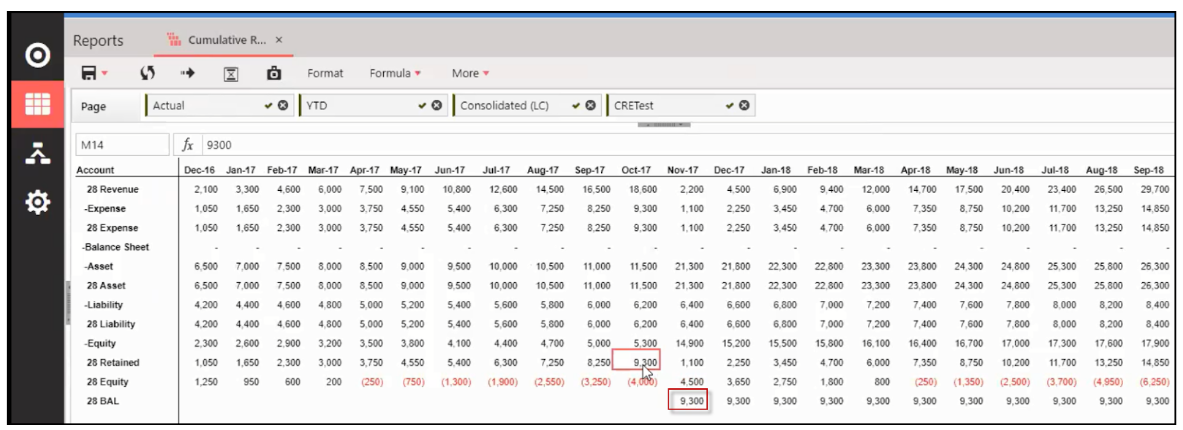
With this feature enabled, using the same Dynamic Report, the account named “Cumulative Retained Earning Account” provides that total based on the prior period total (in this case Oct-17).
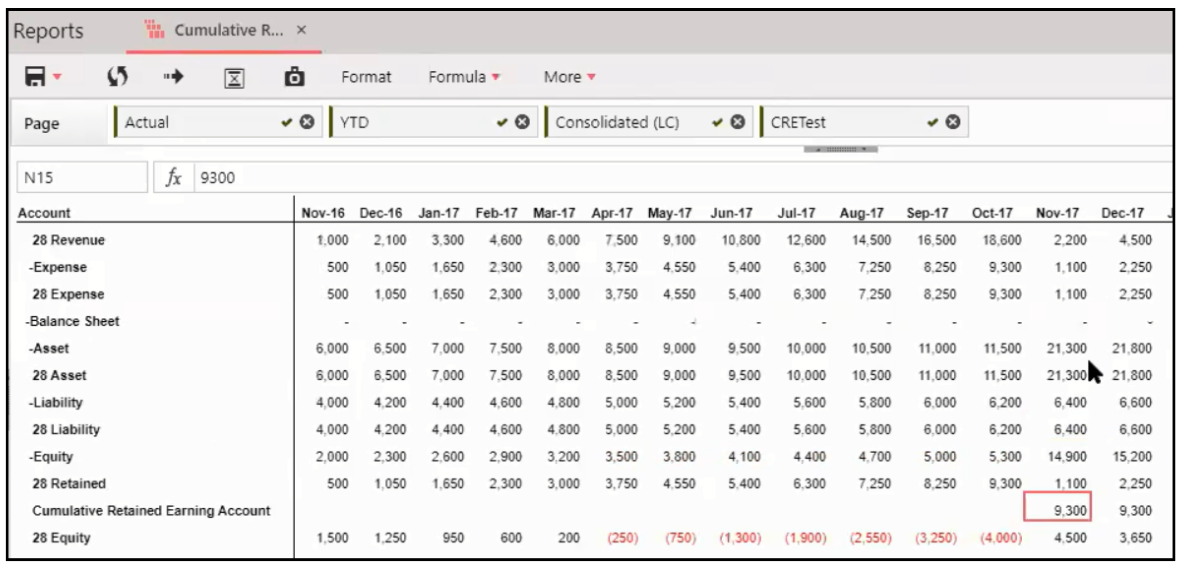
How to Configure Retained Earnings Roll Forward
This functionality is optional. However, if you load month-to-date (MTD) data, this feature will be beneficial.
To enable this feature, complete the following administrative tasks:
- Navigate to Maintenance > Admin > Configuration Tasks.
- Under Consolidation, click Retained Earnings Roll Forward to enable this functionality.
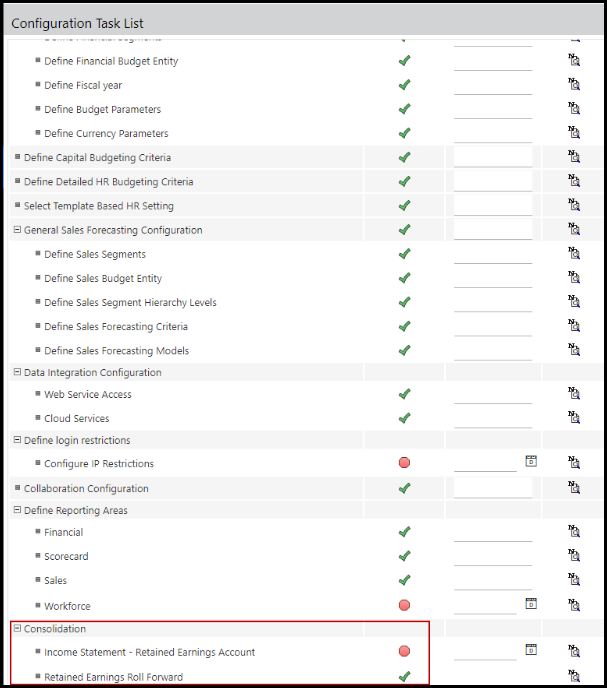
Once the Retained Earnings Roll Forward screen appears (shown below), select Yes for Enable. Selecting Yes for Enable displays additional options in the Consolidation Setup screen allowing the admin user to setup the segment combination to which the financial entries will be posted. Selecting No for Enable hides the options in the Consolidation Setup screen.

- Now that you’ve enabled the settings under Consolidation, access the Consolidation Control Panel and click Consolidation Setup. Notice that Include in the Consolidation Process checkboxes are now displayed on the Consolidation Setup screen for Income Statement - Retained Earnings Account and Cumulative Retained Earnings sections.
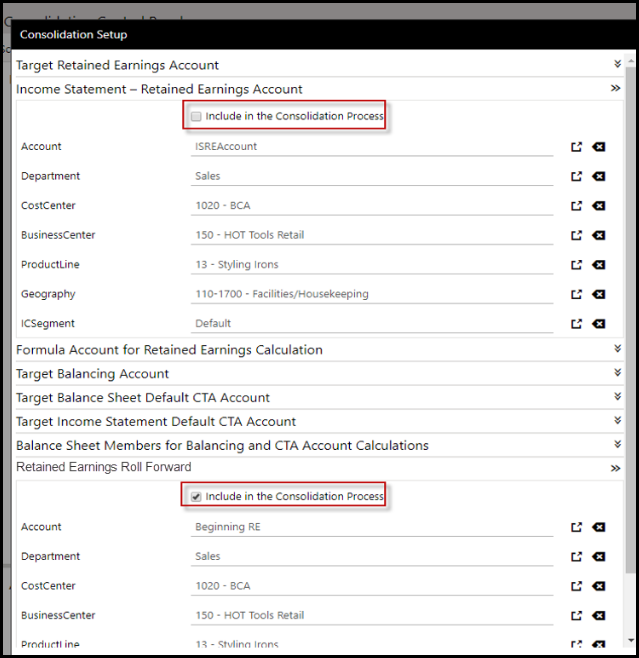
- You must select the checkbox to complete the enablement of this functionality. For Retained Earnings Roll Forward, select the Consolidation Process checkbox so that when you run the Consolidation Process, retained earnings are automatically rolled forward to the next year.
- To disable the Retained Earnings Roll Forward, remove the check from checkbox (Include in the Consolidation Process), save the Consolidation Setup, and rerun the Consolidation Process.
If you want to hide the Retained Earnings Roll Forward section after disabling it, navigate to Maintenance > Admin > Configuration Tasks > Consolidation and select No under Enable. The segment members selected in the Retained Earnings Roll Forward section can be removed after disabling this feature. If required, the segment members can be deleted as soon as the Consolidation Process is rerun after removal from this section to clear the roll forward posting.
In Practice
Navigate to Consolidation.
Select Consolidation Setup.
On the Consolidation Setup page, under Retained Earnings Roll Forward, select the account where you want cumulative retained earnings automatically posted as shown in the example below.
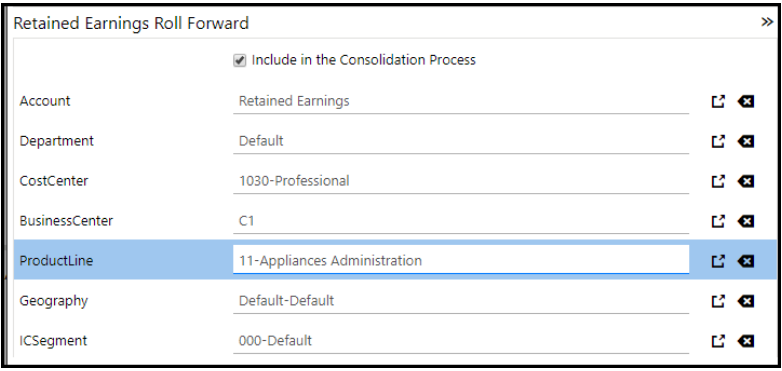
Run the Consolidation Process for the applicable periods.
Check the Detail View log (by clicking the link below) to ensure the process completed successfully.


Create a Dynamic Report to report on Cumulative Retained Earnings.
Retained Earnings Roll Forward Best Practices
Users will see a performance impact when the Consolidation Process is run for a scenario other than the Actual Scenario; the impact will vary based on the number of Interim Currencies and Reporting Currencies defined in the system. It is a best practice to limit the number of Interim and Reporting currencies for optimal performance.
"Enhanced" Retained Earnings Roll Forward
Without this opt-in feature, which is called Enhanced Retained Earnings Roll Forward, the balance is carried forward from the last period of the prior year-end to the first period of the current financial year resulting in Beginning Retained Earnings. The roll forward is calculated using the formula (Retained Earnings YTD balance of Last Period of Previous Financial Year (+) YTD Balance of Beginning Retained Earnings Account of Last Period of Previous Financial Year). No adjustments are allowed to the Roll Forward balance as calculated per the formula. This opt-in feature available as of Fall 18, will allow for adjustments. Once enabled, the amount of the Beginning Retained Earnings will be derived from the account rollup configured as the “Source Account for Beginning Retained Earnings Calculation” instead of the formula above. Users will have to structure the Account Rollup Node under the Equity Rollup to include the Planful Current Year Earnings Account, Beginning Retained Earnings Account, and Adjustment to Retained Earnings Account as leaf members. The Standard Journals or Dynamic Journals can only be used to post adjustments to the Adjustment to Retained Earnings Account. The Account Balance as shown for the Source account rollup for the last period of a financial year will be rolled forward as the Beginning Retained Earnings of the first period of the successive financial year.
Setup for "Enhanced" Retained Earnings Roll Forward
In Practice
To specify a beginning retained earnings account, complete the steps below.
Access the Consolidation Control Panel.
Select Consolidation Setup.
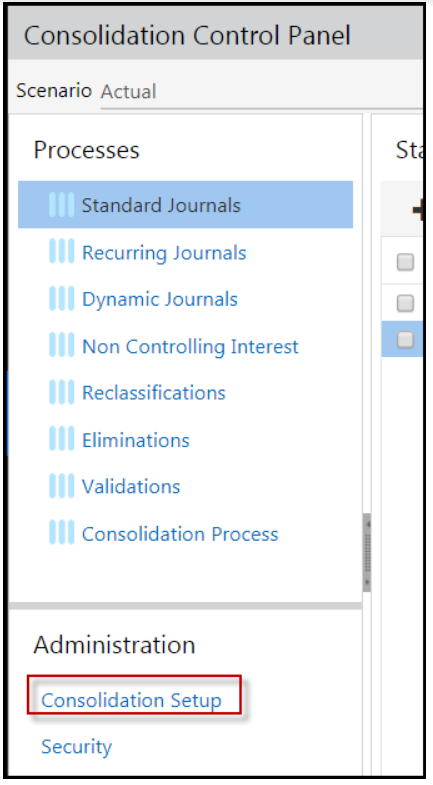
Under Retained Earnings Roll Forward, select the Include in the Consolidation Process checkbox. Selecting this checkbox enables the option to select an account for Beginning Retained Earnings.
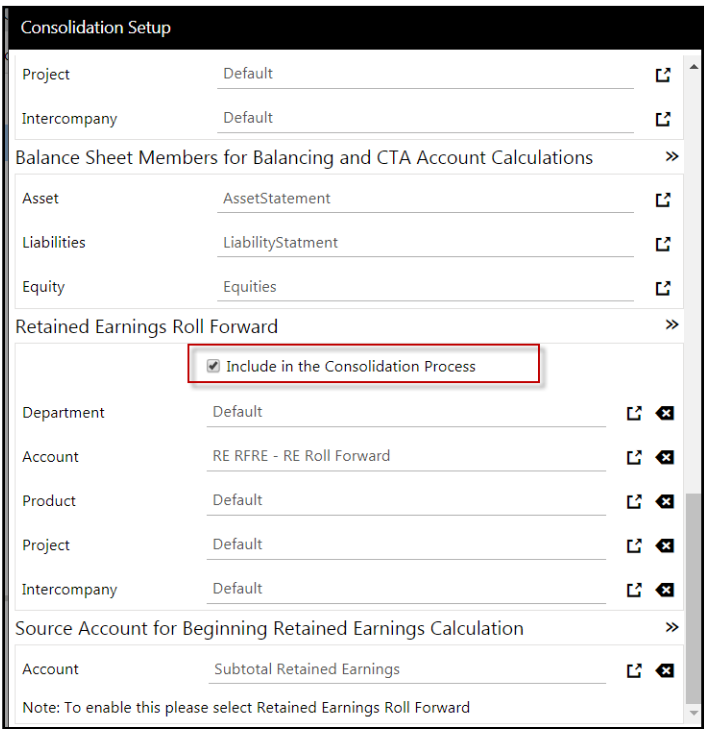
Under Source Account for Beginning Retained Earnings Calculation, select the rollup\parent account which represents the Total Retained Earnings.
Click Save.
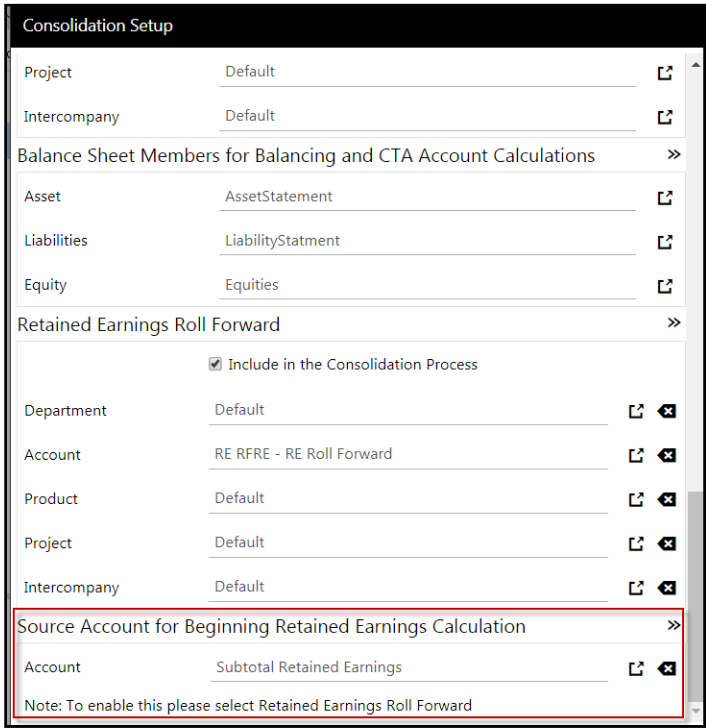
"Enhanced" Retained Earnings Roll Forward Illustration of Use
The image below represents a portion of the financial statements for Financial Years 2016, 2017 and 2018. FY 2016 is the first year of operations. Data for periods 3 through period 11 of FY 2017 are not displayed here and all figures are in YTD.
Current Year Retained Earnings (row 2) is a leaf account setup as the Target Retained Earnings Account in Consolidation Setup. Beginning Retained Earnings (row 3) is the leaf account setup as the Retained Earnings Roll Forward in Consolidation Setup.
Dividends (row 4) and Adjustments (row 5) are leaf account members to be used for making adjustments for Retained Earnings in the Consolidation module.
Current Year Retained Earnings, Beginning Retained Earnings, Dividends and Adjustments are all leaf members of Subtotal Retained Earnings (row 6). All these leaf members have (+) as the Rollup Operator. Subtotal Retained Earnings (row 6) is a Rollup Account under Equity. The account balance of Subtotal Retained Earnings for period 12 of FY 2016 (50) is rolled forward as the Beginning Retained Earnings throughout all periods of FY 2017.
Journal entries have been made to Dividends and Adjustments in period 12 of FY 2017 to affect the adjustments for Retained Earnings which need to be rolled forward as the Beginning Retained Earnings.
The account balance of Subtotal Retained Earnings for period 12 of FY 2017 (88) is rolled forward as the Beginning Retained Earnings throughout all periods of FY 2018.
No currency conversion should be applied to the Beginning Retained Earnings account as the period 12 account balance of a financial year needs to rolled forward in the subsequent financial year.
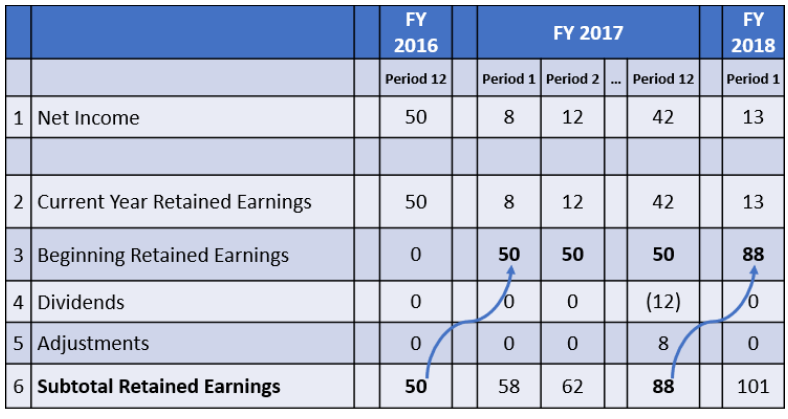
Interim Currency
How to Use Interim Currencies
Set up interim currencies to report on additional currencies other than your local and common currencies. To do so, refresh the reporting cube. When Interim currency calculations occur for the first time (there is no previous period data) for entities in common currency, the resulting scenario MTD (month-to-date) and YTD (year-to-date) calculations will be incorrect. That is , MTD calculations for Balance type accounts and YTD calculations for Flow type accounts will be incorrect. To resolve this issue, run the Consolidation Process for the entire year (beginning of the financial year to the current period). Reprocessing these periods will not impact any of the local or common currency data, but will update the interim currency data for the entities in common currency.
How is Interim Currency Calculated
Interim currency values are calculated for entities having local currency same as the common currency. Planful provides interim currency data for all entities, including the entities having local currency same as the common currency.
When Interim currency calculations occur for the first time (there is no previous period data) for entities which are in common currency, the resulting scenario MTD and YTD calculations will be incorrect. Specifically, MTD calculations for Balance type accounts and YTD calculations for Flow type accounts will be incorrect. To resolve this issue, run the Consolidation Process for the entire year (beginning of the financial year to the current period). Reprocessing these periods will not impact any of the local or common currency data, but will update the interim currency data for the entities in common currency.
Interim Currency Calculation Example
The example below provides a calculation for Interim Currency:
USD = Common Currency; GBP = Local Currency; EUR = Interim Currency
1 GBP = 1.4119 USD = A
1 EUR =1.2661 USD = B
1 GBP =1.11515678 Euro = A/B
960.18 GBP X 1.115157 = 1,070.75, the correct amount in verify data as Interim Currency.
Interim Currency Use Case
The case below provides results when data is updated for a single period without previous period data.
Output in Dynamic report when the Consolidation Process is run for all the periods:
| Account | Measures | Reporting | May-16 | Jun-16 | Jul-16 | Aug-16 | Sep-16 | Oct-16 |
|---|---|---|---|---|---|---|---|---|
15Expense | MTD | Consolidated (CC) | 500 | 550 | 600 | 650 | 700 | 750 |
|
| Interim Currency 1 | 1000 | 1650 | 2400 | 3250 | 4200 | 5250 |
| YTD | Consolidated (CC) | 500 | 1050 | 1650 | 2300 | 3000 | 3750 |
|
| Interim Currency 1 | 1000 | 2650 | 5050 | 8300 | 12500 | 17750 |
Output in Dynamic report when the Consolidation Process is run for one period:
| Account | Measures | Reporting | May-16 | Jun-16 | Jul-16 | Aug-16 | Sep-16 | Oct-16 |
|---|---|---|---|---|---|---|---|---|
15Expense | MTD | Consolidated (CC) | 500 | 550 | 600 | 650 | 700 | 750 |
|
| Interim Currency 1 |
|
|
|
|
| 17750 |
| YTD | Consolidated (CC) | 500 | 1050 | 1650 | 2300 | 3000 | 3750 |
|
| Interim Currency 1 |
|
|
|
|
| 17750 |
How to Setup Interim Currency
Currency Exchange rates are used in calculating Common Currency and Interim Currency numbers. It's important to enter the correct exchange rates for a currency type, scenario, and company combination. If exchange rates are not entered for the Interim Currency company, the application populates the Common Currency numbers as part of Interim Currency in reports.
Complete the following steps to set up Interim Currency:
- Create interim currencies.
- Map interim currencies to companies.
- Make sure currency exchange rates are entered against interim currencies for all appropriate currency types.
- Run the Consolidation Process. Important! You must save the exchange rate table in order for currency exceptions to be processed. This is required for users that are not using the Consolidation Process.
- Process the reporting cube and validate the data in reports.
Interim Consolidations at a Currency Other Than Local and Common
In the hierarchy below, to generate a report for Europe in the EUR, you would select Europe rollup member for the Company and then IC1 from the Reporting dimension. Local Currency does not make sense at the parent level as it will be an aggregation of the Local Currency from the children that are in different currencies. Selecting Common Currency at the parent level will make sense and include the appropriate rollups as well as Elimination data.
Total Corp (CC = USD)
North America (Desired currency USD can be accomplished by displaying CC in report)
US (LC = USD)
Canada (LC = CND)
Mexico (LC = MXP)
Europe (Desired currency EUR can be accomplished by setting all children to the same IC)
England (GBP) IC1 = EUR
Spain (EUR) IC1 = EUR
France (EUR) IC1 = EUR
Asia (Desired currency as CNY and USD. USD can be accomplished by displaying CC in a report. Setting all children to the same IC will enable reporting at CNY currency)
China (CNY) IC1 = CNY
Japan (JPY) IC1 = CNY
Entity Currency
What is Entity Currency and How to Set It Up
Use Entity Currency to generate cash flow reports in local currency. Complete the following steps to post a local currency to a reporting member in the Reporting Hierarchy.
To add an Entity Currency to a reporting member:
Navigate to Maintenance > Hierarchy > Hierarchy Management.
Select Finance Hierarchies as Type, then select Reporting for both Dimension and Hierarchy.
Click Show. Select the Reporting Currency node you want to apply an Entity Currency to.
From the Segment Properties section of the Properties pane, expand Currency Code, select Entity Currency as the Currency Code, then click Save.
Click Save to save the changes. The entity currency can now be used as a reporting currency when you run your reports.
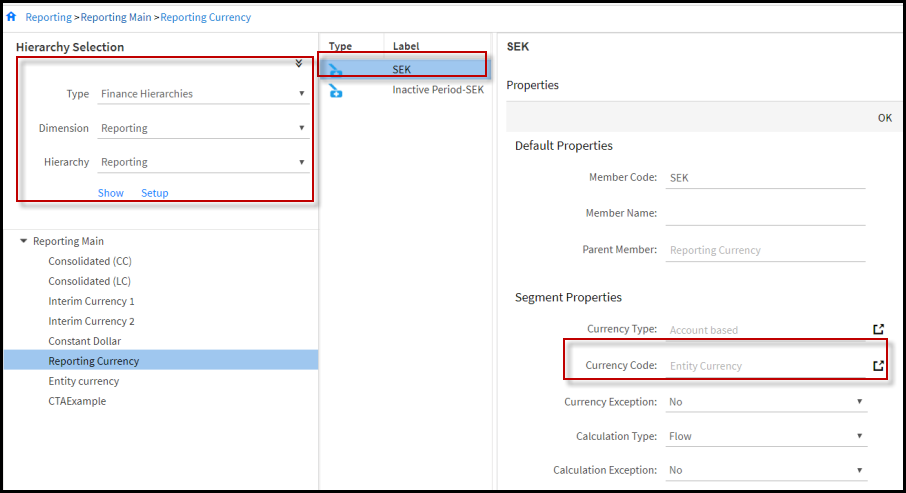
When the reporting member is added to a Dynamic Report, the Entity Currency is displayed.
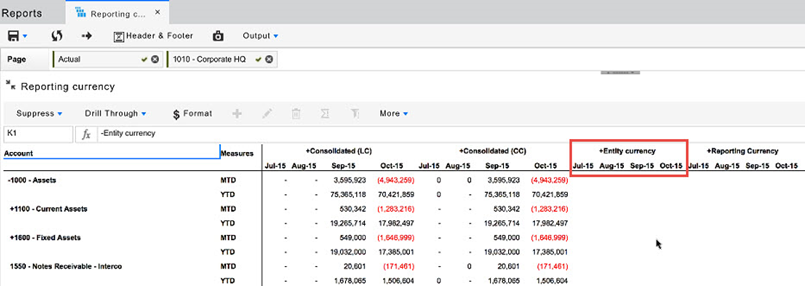
Additionally, the following options are also available in the Segment Properties section:
Do Not Consider Opening Balance—Select if you want YTD values calculated in the first period to exclude the opening balance of the previous period.
Do Not Consider CC Data—Select if you do not want the common currency value to be converted and reported in local currency.
